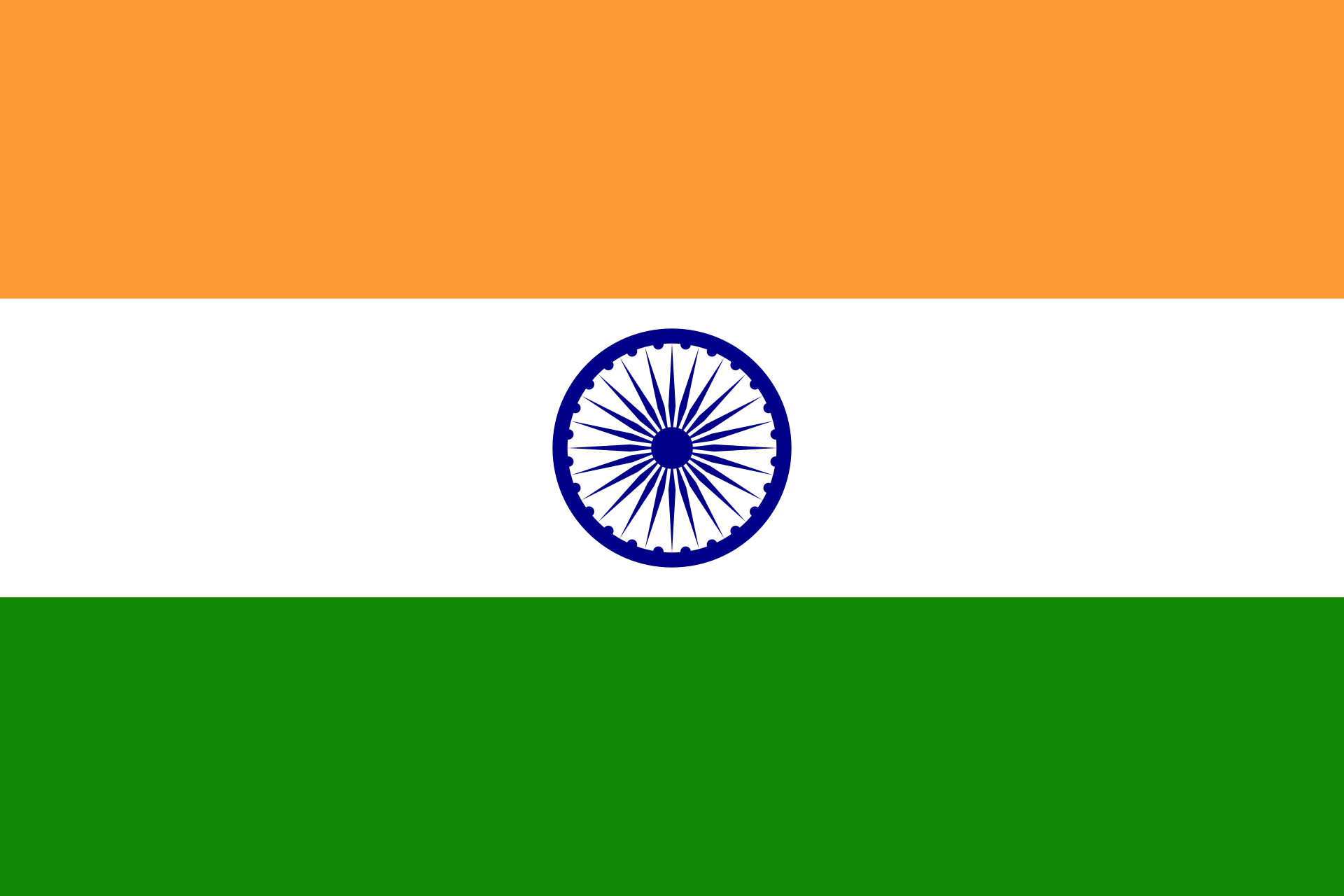National Symbols: Flag Details
Date First Used
July 22, 1947
Nickname(s)
Tiranga
Design Elements
The Indian flag is a horizontal tricolor in equal proportions of deep saffron on the top, white in the middle and dark green at the bottom. The center of the white band features a navy blue wheel.
Symbols: A 24-spoked wheel to indicate the Ashoka Chakra, the wheel of law featured on the Sarnath Lion Capital, a nationally revered sandstone sculpture. The Chakra symbolizes the power of the state governed by Dharma, which is the primordial Indian system of justice. This center symbol dates back to the Third Century BC reign of Emperor Ashoka and demonstrates that there is life in movement and death in stagnation.
Colors: The saffron stands for courage and sacrifice; the white, for purity and truth; the green, for growth and auspiciousness.
Proportions: The ratio of the width to the length of the flag is 2:3. The wheel's diameter approximates the width of the white band.
Variations: The Civil Ensign features the Tiranga in the canton (upper-left quadrant) on a field of red.
History
On August 15, 1947, after a bitterly fought battle for sovereignty from the British Crown, the dominions of India and Pakistan were established. India already had a national flag at the ready for the occasion. In fact, a flag resolution was voted on by an ad hoc meeting of the Constituent Assembly a full 24 days before the official announcement of independence. The assembly chose a familiar template for the flag's design: the flag of the Indian National Congress, the leading party of the country's independence movement. The INC's horizontal tricolor of orange, white, and green was used, but the new national flag featured an Ashoka Chakra (the “wheel of Dharma”) at its center, replacing a blue Charka (spinning wheel) used by the INC (and derived from Mahatma Gandhi's call for economic self-sufficiency through spinning cotton by hand). This was done to add historical "depth" and help separate the national flag from the INC party flag. The tricolor had been used unofficially since the early 1920s, with the colors then representing Hinduism (orange), Islam (green) and a hoped-for unity and peace (white). Now, they officially represented courage, truth, and the growth of the free Indian state. Pandit Nehru, who would become the first and longest-serving prime minister of independent India, presented the proposed design to the Constituent Assembly, and the tricolor was adopted as India’s official flag by unanimous vote.
Proper Uses
Previous to changes made to the Flag Code, the national flag was strictly a state flag, and could only be used by private citizens in certain circumstances. On January 26, 2002, that all changed. After 52 years, the citizens of India were now free to fly the Indian flag over their homes, offices, schools and factories on any day. In short, any citizen or public or private institution may hoist/display the national flag on all days and occasions, ceremonial or otherwise, consistent with the "dignity and honor" of the national flag.
However, the revised Flag Code still contains many restrictions. As far as possible, it should be flown from sunrise to sunset, irrespective of the weather. The flag cannot be intentionally allowed to touch the ground or the floor or trail in water. It cannot be draped over the hood, top, and sides or back of vehicles, trains, boats or aircraft. No other flag or bunting can be placed higher than the flag. Also, no object—including flowers, garlands or emblems—can be placed on or above the flag.
In 2005, the Indian Parliament adopted a new law banning the use of the flag on underwear or on any other clothing worn below the belt, deeming such use an “insult” to the national symbol. The legislation also makes it illegal to embroider national symbols on pillowcases and handkerchiefs.
Legends, Controversies, and Trivia
The Hindustan Times distributed free paper national flag souvenirs with its July 28, 1947, edition to acquaint Indians with the approved design.The Times, no doubt, was also motivated by the desire to sell more newspapers—the Flag Code of 1950, which barred all uses of the flag for commercial purposes, had not yet gone into effect.
The Indian Flag Code was often criticized for being too rigid in that it prevented ordinary citizens from displaying the flag on homes and other buildings. For many years, only government officials and other government buildings could display the flag. That changed in 2001 when Naveen Jindal won a case in the Supreme Court of India, giving Indians the right to unfurl the flag publicly. This led to the revised, relaxed Flag Code of 2002.
Unofficially, India's flag was patterned on the flag of another modern example of national struggle against British imperialism, the Republic of Ireland.
Official flag specifications require that the flag be made only of khadi, a special type of hand-spun cloth popularized by Gandhi.
Copyright © 1993—2025 World Trade Press. All rights reserved.

 India
India 